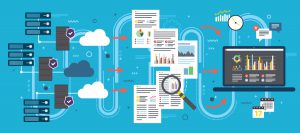The need for efficient decision-making and business processes has been increasing exponentially, especially in the recent past. This is a consequence of technological breakthroughs in analytics and their success with early adopters who gain a competitive advantage. The major players in an ecosystem understand this phenomenon and progressively adopt those technologies, pushing everybody else in the ecosystem to transform or to be left behind.
It becomes imperative for organizations now to adopt a data analytics practice, closely integrate it with business processes, improve it based on innovations, and more importantly, continually adjust the models by evaluating their relevance and questioning the applicability of assumptions made to build them.
Because organizations increasingly operate in an ecosystem to which data is fundamental — both internally and externally — it is critical to leverage internal organizational data and integrate it with valuable external data sources to understand consumer needs & behavioral patterns, discover trends in the business ecosystem, scientifically generate predictions, and leverage these insights to empower a more impactful decision making.
90% of corporate strategies will formally recognize the significance of information assets and analytics as an essential competency by 2022, according to Gartner.
Redefining Digital Transformation Journey During Unprecedented Times
The COVID-19 pandemic, however, has severely hampered the ability of organizations to glean meaningful insights and extrapolate past trends. Since machine learning-based analytics models were built with data and assumptions suitable in the pre-pandemic world, these models fail to respond precisely to the highly abnormal patterns in the data generated during the pandemic. For example, consumer discretionary spending and oil prices have crashed as the pandemic unfolded.
Even when the pandemic is over, and the world settles in the new normal, the re-engineered or pre-pandemic models can become obsolete as the pandemic will leave behind long-lasting fundamental changes. This again requires readjusting or creating new analytical models to glean scenario-relevant business insights and predictions. For instance, Human Resource (HR) capabilities, such as integrated HR systems, easy and quick access to real-time workforce data, and self-service option, are now fundamental requirements for every organization. Businesses must transform HR functions by leveraging the data to derive insights across HR functions such as workforce planning, recruitment, employee engagement, and performance management. Similarly, other business functions, including Inventory, Supply Chain, and Logistic Management, are also undergoing drastic changes. They would need to employ data analytics for better real-time asset monitoring, inventory analysis, and predictive maintenance to navigate this paradigm shift, curb operational inefficiencies and reduce overall operating costs. Therefore, the organizations that have already established a robust data analytics practice and dynamic analytical models can stay ahead and will enjoy the greatest competitive advantage while others in the ecosystem scramble to generate revenue.
How Should Organizations Navigate with Data Analytics?
It can be overwhelming for organizations in the initial stages of implementing a data analytics practice. The key is to focus on solving specific problems instead of vaguely defining how to leverage data analytics. For example, setting a goal like “find patterns in the data available to us” may not yield promising results.
On the other hand, a goal like “optimize operational costs” would provide a clearer path towards approaching data analytics and finding improvement opportunities that provide the most leverage. It is also important to note that analytics may not help gain a significant advantage quickly. It requires consistently improving more elemental objects in a process. Consequently, the smaller improvements provide compounding benefits over time.
Senior executives should also recognize that the best approach to analytics-driven optimization or decision-making should be a continuous, cyclical process that helps implement, analyze, learn, and improve analytical techniques and models. This includes testing hypotheses and assumptions to improve the efficacy of modals in various scenarios. In some scenarios, internal data sets may not be sufficient to derive insights for decision-making and should consider integrating valuable external data sources. Organizations can only build such a capability over a period of time due to the complexity of data products available in the market and the difficulty in assessing data quality.
Consumer product sales data, for example, may not accurately reflect the spending pattern during the pandemic lockdowns. If the brands were making hygiene products such as sanitizers or disinfectants, the data would reflect heavy consumer spending. But other non-essential products wouldn’t show similar patterns. Hence, biased data is a factor in play here that should smoothen out through effective assumptions, which play a vital role in enhancing accuracy or pinpointing the root cause better to help with better decision-making.
Of course, this is a simplified example, but only relying on internal datasets may not provide more valuable insights. An organization can gauge more accurate trends by acquiring or integrating broader ecosystem data like transactional data from retail and digital outlets. This helps to minimize or halt the production of products in less demand and leverage existing capabilities to introduce new products relevant to the short-term demand. Once the pandemic subsides, the organization could assess the conditions using analytics to rethink its strategy.
Above all, it is quintessential to integrate insights into decision-making and embed them into business processes to drive efficiency and innovation. Executive buy-in is another crucial factor; more importantly, having an ROI-based approach will help quantify the benefits derived from these analytical models and any revisions that might be necessary. In the end, building comprehensive analytical models would offer no advantage if the insights produced are not leveraged to achieve better outcomes. Therefore, without executive buy-in, organizations fail to drive profitable results from their analytics practice even if they build strong teams and analytical processes.
Data Analytics Applications: Generating Business Value
A German automotive pioneer was facing several challenges in its manufacturing process. It faced a couple of significant challenges, including scattered data across multiple systems and variation in the cost of manufacturing the same products across production units in various geo-locations. The manufacturer collaborated with Motherson Technology Services to implement an analytics-driven approach to centralize data management, address any inefficiencies across sub-processes, and drive down procurement costs with better forecasts.
Firstly, the manufacturer focused on centralizing data and collecting additional data points where required. This helped to monitor various systems and processes more transparently and gain precise insights for optimization. It also helped forecast raw material requirements more accurately, giving a substantial advantage in negotiating contracts and selecting reliable, high-quality suppliers. All of this helped the manufacturer cut down raw material costs by USD 6 million annually. But the broader advantage was that the manufacturing company defined more business problems and implemented analytical solutions to solve them, gaining a substantial competitive advantage.
Conclusion
Implementing an analytics practice can be an arduous task and is prone to deliver insignificant results. Organizations can start by defining smaller goals and test the effectiveness of analytical techniques with a small team of exceptional individuals who have experience in implementing analytical solutions. Alternatively, organizations can collaborate with reputed partners like Motherson Technology Services, who have proven experience across industries and expertise to help organizations strategically improve their business operations
About the Author:

Hariharan Ramakrishnan leads the Digital and Analytics services at Motherson Technology Services Limited. A multi-disciplinary business leader with 20 plus years of experience in the digital transformation space, he is instrumental in helping enterprises evolve their digital strategy to enhance their revenues whilst improving customer experience, and optimising cost. A frequent speaker at industry & technology forums, he continues to author various thought leading articles on technology related trends















































